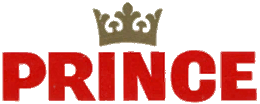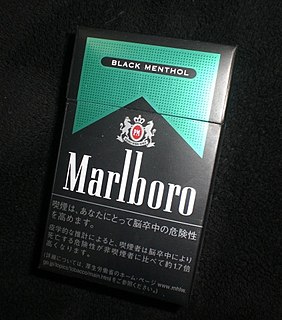Related Research Articles

Liquorice or licorice is the common name of Glycyrrhiza glabra, a flowering plant of the bean family Fabaceae, from the root of which a sweet, aromatic flavouring can be extracted.

Prince is a Danish brand of cigarettes, owned by multinational British American Tobacco, and produced by House of Prince, which until 2008 was a subsidiary of the Scandinavian Tobacco Company.

Nicotine marketing is the marketing of nicotine-containing products or use. Traditionally, the tobacco industry markets cigarette smoking, but it is increasingly marketing other products, such as electronic cigarettes and heated tobacco products. Products are marketed through social media, stealth marketing, mass media, and sponsorship. Expenditures on nicotine marketing are in the tens of billions a year; in the US alone, spending was over US$1 million per hour in 2016; in 2003, per-capita marketing spending was $290 per adult smoker, or $45 per inhabitant. Nicotine marketing is increasingly regulated; some forms of nicotine advertising are banned in many countries. The World Health Organization recommends a complete tobacco advertising ban.

Candy cigarettes are a candy introduced in the late 19th century made out of chalky sugar, bubblegum or chocolate, wrapped in paper and packaged and branded so as to resemble cigarettes. Some products contain powdered sugar hidden in the wrapper, allowing the user to blow into the cigarette and produce a cloud of sugar that imitates smoke, which comes out of the other end.

A menthol cigarette is a cigarette flavored with the compound menthol.

Merit is an American brand of cigarettes, currently owned and manufactured by Philip Morris USA in the United States and Philip Morris International outside the United States.

Smoking is a practice in which a substance is burned and the resulting smoke is breathed in to be tasted and absorbed into the bloodstream. Most commonly, the substance used is the dried leaves of the tobacco plant, which have been rolled into a small rectangle of rolling paper to create a small, round cylinder called a "cigarette". Smoking is primarily practised as a route of administration for recreational drug use because the combustion of the dried plant leaves vaporizes and delivers active substances into the lungs where they are rapidly absorbed into the bloodstream and reach bodily tissue. In the case of cigarette smoking these substances are contained in a mixture of aerosol particles and gases and include the pharmacologically active alkaloid nicotine; the vaporization creates heated aerosol and gas into a form that allows inhalation and deep penetration into the lungs where absorption into the bloodstream of the active substances occurs. In some cultures, smoking is also carried out as a part of various rituals, where participants use it to help induce trance-like states that, they believe, can lead them to spiritual enlightenment.

A flavored tobacco product is a tobacco product with added flavorings. Flavored tobacco products include types of cigarettes, cigarillos and cigars, hookah and hookah tobacco, and various types of smokeless tobacco. Flavored tobacco products are especially popular with youth and have therefore become targets of regulation in several countries.

The Family Smoking Prevention and Tobacco Control Act, is a federal statute in the United States that was signed into law by President Barack Obama on June 22, 2009. The Act gives the Food and Drug Administration the power to regulate the tobacco industry. A signature element of the law imposes new warnings and labels on tobacco packaging and their advertisements, with the goal of discouraging minors and young adults from smoking. The Act also bans flavored cigarettes, places limits on the advertising of tobacco products to minors and requires tobacco companies to seek FDA approval for new tobacco products.

Cigarette smoking has serious health effects. In the "General health effects" and the "Unique gender differences and health effects for women" sections, this article gives specific statistics on the health effects on women and in general.

Smoking and Health: Report of the Advisory Committee to the Surgeon General of the United States was a landmark report published on January 11, 1964, by the Surgeon General's Advisory Committee on Smoking and Health, chaired by the then Surgeon General of the United States, Dr. Luther Leonidas Terry, M.D., regarding the negative health effects of tobacco smoking. Although it was not the first such declaration—or even the first declaration by an official of the United States of America—it is notable for being arguably the most famous such declaration and has had lasting and widespread effects both on the tobacco industry and on the worldwide perception of smoking.

Plain tobacco packaging, also known as generic, neutral, standardised or homogeneous packaging, is packaging of tobacco products, typically cigarettes, without any branding, including only the brand name in a mandated size, font and place on the pack, in addition to the health warnings and any other legally mandated information such as toxic constituents and tax-paid stamps. The appearance of all tobacco packs is standardised, including the colour of the pack.

Proposition 29, the California Cancer Research Act, is a California ballot measure that was defeated by California voters at the statewide election on June 5, 2012.

Professor Ann McNeill is a British academic and tobacco policy expert. She is currently a Professor of Tobacco Addiction in the National Addictions Centre at the King's College London Institute of Psychiatry and Deputy Director of the UK Centre for Tobacco Control Studies.
Regulation of electronic cigarettes varies across countries and states, ranging from no regulation to banning them entirely. For instance, e-cigarettes were illegal in Japan, which forced the market to use heat-not-burn tobacco products for cigarette alternatives. Others have introduced strict restrictions and some have licensed devices as medicines such as in the UK. However, as of February 2018, there is no e-cigarette device that has been given a medical license that is commercially sold or available by prescription in the UK. As of 2015, around two thirds of major nations have regulated e-cigarettes in some way. Because of the potential relationship with tobacco laws and medical drug policies, e-cigarette legislation is being debated in many countries. The companies that make e-cigarettes have been pushing for laws that support their interests. In 2016 the US Department of Transportation banned the use of e-cigarettes on commercial flights. This regulation applies to all flights to and from the US. In 2018, the Royal College of Physicians asked that a balance is found in regulations over e-cigarettes that ensure product safety while encouraging smokers to use them instead of tobacco, as well as keep an eye on any effects contrary to the control agencies for tobacco.
The scientific community in United States and Europe are primarily concerned with the possible effect of electronic cigarette use on public health. There is concern among public health experts that e-cigarettes could renormalize smoking, weaken measures to control tobacco, and serve as a gateway for smoking among youth. The public health community is divided over whether to support e-cigarettes, because their safety and efficacy for quitting smoking is unclear. Many in the public health community acknowledge the potential for their quitting smoking and decreasing harm benefits, but there remains a concern over their long-term safety and potential for a new era of users to get addicted to nicotine and then tobacco. There is concern among tobacco control academics and advocates that prevalent universal vaping "will bring its own distinct but as yet unknown health risks in the same way tobacco smoking did, as a result of chronic exposure", among other things.

Juul Labs, Inc. is an American electronic cigarette company that spun off from Pax Labs in 2017. It makes the Juul electronic cigarette, which atomizes nicotine salts from leaf tobacco supplied by one-time use cartridges.
A heated tobacco product (HTP) is a tobacco product that heats the tobacco at a lower temperature than conventional cigarettes. These products contain nicotine, which is a highly addictive chemical. The heat generates an aerosol or smoke to be inhaled from the tobacco, which contains nicotine and other chemicals. HTPs may also contain additives not found in tobacco, including flavoring chemicals. HTPs generally heat tobacco to temperatures under 600 °C (1100 °F), a lower temperature than conventional cigarettes. HTPs use embedded or external heat sources, heated sealed chambers, or product-specific customized cigarettes. Whereas e-cigarettes are electronic devices that vaporize a liquid containing nicotine, HTPs usually use tobacco in leaf or some other solid form, although there are some hybrid products that can use both solid tobacco and e-liquids. There are various types of HTPs. The two most common designs are those that use an electric battery to heat tobacco leaf and those that use a carbon ember that is lit and then heats the tobacco. There are similar devices that heat cannabis instead of tobacco.

Since the introduction of electronic cigarettes to the market in 2002, their global usage has risen rapidly. The global number of adult e-cigarette users rose from about 7 million in 2011 to 41 million 2018. Awareness and use of e-cigarettes greatly increased over the few years leading up to 2014, particularly among young people and women in some parts of the world. Since their introduction vaping has increased in the majority of high-income countries. E-cigarette use in the US and Europe is higher than in other countries, except for China which has the greatest number of e-cigarette users. Growth in the UK as of January 2018 had reportedly slowed since 2013. The growing frequency of e-cigarette use may be due to heavy promotion in youth-driven media channels, their low cost, and the belief that e-cigarettes are safer than traditional cigarettes, according to a 2016 review. E-cigarette use may also be increasing due to the consensus among several scientific organizations that e-cigarettes are safer compared to combustible tobacco products. E-cigarette use also appears to be increasing at the same time as a rapid decrease in cigarette use in many countries, suggesting that e-cigarettes may be displacing traditional cigarettes.
Electronic cigarettes are marketed to smoking and non-smoking men, women, and children as being safer than traditional cigarettes. E-cigarette businesses have considerably accelerated their marketing spending. All of the large tobacco businesses are engaging in the marketing of e-cigarettes. For the majority of the large tobacco businesses these products are quickly becoming a substantial part of the total advertising spending. E-cigarette businesses have a vested interest in maximizing the number of long-term product users. The entrance of traditional transnational tobacco businesses in the marketing of such products is a serious threat to restricting tobacco use. E-cigarette businesses have been using intensive marketing strategies like those used to publicize traditional cigarettes in the 1950s and 1960s. While advertising of tobacco products is banned in most countries, television and radio e-cigarette advertising in several countries may be indirectly encouraging traditional cigarette use.
References
- 1 2 "Charlotta Pisinger". Altinget. 11 December 2018. Retrieved 17 September 2019.
- 1 2 3 Pickering, Birgitte. "Charlotta Holm Pisinger". Frederiksberg Hospital. Retrieved 17 September 2019.
- 1 2 3 Doward, Jamie; Fraser, Tali (14 September 2019). "UK attacked for defence of flavoured e-cigarettes". The Observer. Retrieved 17 September 2019.